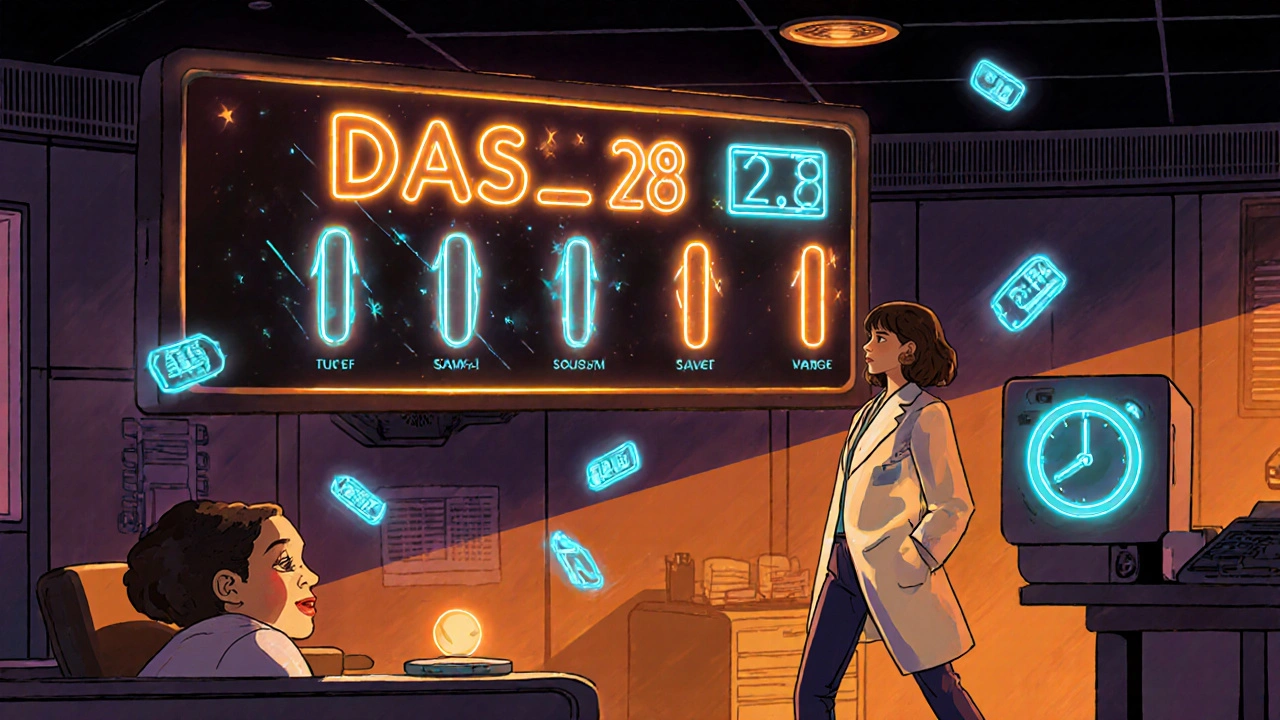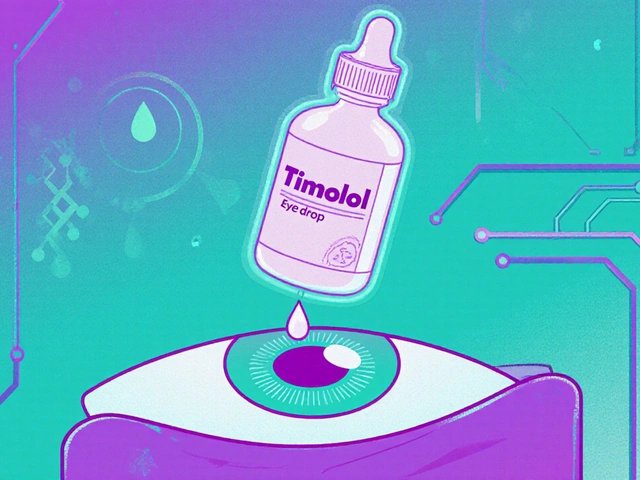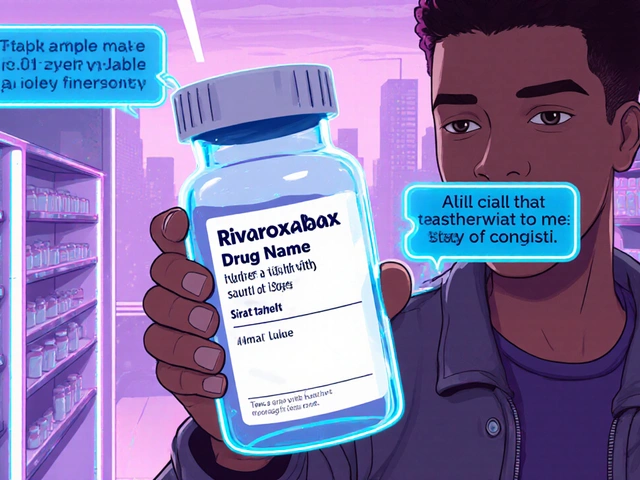
For years, people with rheumatoid arthritis (RA) were told to manage symptoms and hope for the best. Medications were adjusted slowly, based on how the patient felt or what the doctor noticed during a quick exam. But that’s not enough anymore. Today, rheumatoid arthritis remission isn’t a lucky accident-it’s a goal you can reach with the right strategy. And the most proven way to get there? Treat-to-target, or T2T.
What Treat-to-Target Really Means
Treat-to-target isn’t just a buzzword. It’s a clear, step-by-step plan where your doctor sets a specific goal-usually remission or low disease activity-and then adjusts your treatment every few weeks or months until you hit it. No guessing. No waiting. Just data-driven decisions. The most common target is DAS28 < 2.6. That’s the Disease Activity Score using 28 joints. It’s not just about pain or swelling. It combines joint counts, blood markers like CRP or ESR, and how you’re feeling overall. If your score stays above 2.6 after three months, your treatment changes. Not next year. Not next visit. Three months. This approach didn’t come out of thin air. The DREAM trial in the Netherlands tracked over 400 people with early RA who were treated this way. At 12 months, nearly 60% reached remission. Compare that to traditional care, where only about 30% did. The TICORA and BeSt trials confirmed it: if you treat to a target, you’re more than twice as likely to get into remission.How It Works: The Step-by-Step Path
T2T isn’t one-size-fits-all, but it follows a clear ladder. Here’s how it typically unfolds:- Start with methotrexate. This is the backbone of RA treatment. Most people get 10-25 mg per week, often with folic acid to reduce side effects.
- If no improvement in 3 months? Add another conventional DMARD-like sulfasalazine or hydroxychloroquine. Triple therapy (methotrexate + sulfasalazine + hydroxychloroquine) works better than single drugs for many.
- If still not in remission? Move to biologics or JAK inhibitors. TNF blockers like adalimumab or etanercept are common first choices. If those don’t work, options like tocilizumab (IL-6 blocker) or baricitinib (JAK inhibitor) step in.
Why This Works Better Than Old Methods
Before T2T, treatment was reactive. You had a flare? Take more steroids. Your joints hurt? Try a different pill. But without measuring disease activity, you never knew if you were actually improving-or just masking symptoms. T2T flips that. It’s proactive. It’s measurable. And it’s backed by real numbers. In the CAMERA-II trial, 50% of patients reached remission after two years with T2T. In the control group? Only 28%. That’s not a small difference. That’s life-changing. People kept their joints. They stayed employed. They played with their grandkids without pain. Even more telling: in early RA (symptoms under a year), T2T cut the time to remission in half-from 52 weeks to just 25. That’s more than a year of damage prevented.
What Success Looks Like in Real Life
Real-world results mirror the trials. A 2021 survey by the Arthritis Foundation found that 68% of RA patients whose doctors used T2T reported better disease control. Only 42% of those on routine care said the same. One woman from Perth, diagnosed in 2022, shared her story on a patient forum: “I’d been in pain for three years. My old doctor said, ‘It’s just RA, we’ll manage it.’ Then I switched to a rheumatologist who used DAS28 every 8 weeks. At 6 months, my score dropped from 5.1 to 1.9. I’m in remission. I haven’t taken prednisone in 14 months.” But it’s not always smooth. Some patients feel discouraged when remission doesn’t happen. “I did everything right,” one user wrote on MyRheumaTeam. “Still couldn’t get below 2.6. Felt like a failure.” That’s where T2T needs nuance. Not everyone reaches full remission-and that’s okay. The goal is to reduce damage and improve quality of life. For some, low disease activity (DAS28 2.6-3.2) is a win. The 2022 EULAR guidelines now say: targets should be personalized. If you’re working, sleeping well, and pain-free, that matters more than a number.Barriers to Getting It Right
Here’s the problem: even though T2T is in every major guideline, most doctors aren’t doing it right. A 2022 study found only 41% of rheumatologists and patients agreed on what the treatment goal was. Only 58% of doctors use standardized scores like DAS28 at every visit. Some still rely on how you “look” or if you’re taking your pills. Why? Time. Training. Resources. Counting 28 joints properly takes 10-15 minutes. Calculating DAS28 manually is tedious. Most private clinics don’t have the staff or tech to do it consistently. Solutions are emerging. Electronic health records now have built-in DAS28 calculators. Nurse practitioners can handle routine check-ins. The ACR’s Treat to Target app has been downloaded over 15,000 times. The EULAR toolkit offers free guides in 12 languages.Who Benefits the Most?
T2T works best for people with early RA-those diagnosed within the first year. The data is strongest here. But it’s not useless for those with longer-standing disease. In the TEAR trial, even patients with RA for over 5 years saw better outcomes with T2T: 65% reached low disease activity compared to 52% with usual care. It doesn’t always mean remission-but it means less joint damage, fewer flares, and less need for surgery. The key is consistency. If you’ve had RA for 10 years and your joints are already damaged, remission might be out of reach. But stopping progression? That’s still possible. And that’s worth fighting for.
The Future: Smarter, Faster, Personalized
T2T isn’t standing still. New research is making it even sharper. The RACAT trial in 2023 combined T2T with early biomarker testing-looking at blood proteins that predict who responds to which drug. Remission rates jumped to 68% in one year. Even more exciting? Digital tools. The DART trial is testing a smartphone app that tracks joint pain, stiffness, and fatigue daily. It feeds that data into your doctor’s system, so they can spot changes before you even notice them. Experts like Dr. Iain McInnes predict that within five years, T2T will use genetic and molecular data to choose your first drug-not trial and error. Imagine starting treatment knowing which drug has a 90% chance of working for you. That’s the next frontier.What You Can Do Today
If you have RA, here’s how to start using T2T:- Ask your rheumatologist: “What’s my DAS28 score? What’s our target?”
- Request a written plan: “If I’m not at target in 3 months, what’s next?”
- Track your symptoms between visits-pain, stiffness, fatigue. Use a simple app or notebook.
- Don’t accept vague answers like “You’re doing fine.” If your score is above 2.6, ask why you’re not changing treatment.
- Know your options: methotrexate, triple therapy, biologics, JAK inhibitors. Understand the risks and benefits.
Final Thought: Remission Is Possible
Rheumatoid arthritis doesn’t have to mean lifelong pain. The days of settling for “managing” symptoms are over. With treat-to-target, remission is a realistic, measurable goal-not a dream. It takes effort-from you and your doctor. But the payoff is huge: less pain, no joint damage, more years of living fully. You don’t need to be perfect. You just need to be consistent. And you need to demand more than just a pill. You need a plan.Can rheumatoid arthritis really go into remission?
Yes. With treat-to-target strategies, up to 60% of people with early rheumatoid arthritis achieve remission within a year. Remission means no signs of active disease-no swelling, no pain, normal blood markers. It doesn’t mean the disease is gone forever, but it’s under control. Many people stay in remission for years with ongoing, low-dose treatment.
What is DAS28 and why does it matter?
DAS28 is a scoring system that measures rheumatoid arthritis disease activity using 28 joints, blood tests (CRP or ESR), and your own report of how you’re feeling. A score below 2.6 means remission. Between 2.6 and 3.2 is low disease activity. It’s objective, repeatable, and used in every major clinical trial. Without it, doctors can’t tell if treatment is working.
How often should I get checked if I’m on treat-to-target?
When your RA is active, you should be assessed every 1 to 3 months. Once you reach remission or low disease activity, checks can drop to every 3 to 6 months. The key is regular monitoring-no long gaps. Skipping visits means missed opportunities to adjust treatment before damage happens.
What if I can’t reach remission?
Remission isn’t the only win. Low disease activity (DAS28 2.6-3.2) still means significantly less joint damage and better quality of life. Some people prioritize being able to work, sleep, or play with their kids over hitting an exact number. Your doctor should help you set a realistic goal based on your life-not just a score.
Are biologics and JAK inhibitors safe for long-term use?
They’re generally safe when monitored. Biologics and JAK inhibitors lower immune system activity, so there’s a small increased risk of infections or, rarely, certain cancers. But the risk of joint destruction from uncontrolled RA is far higher. Doctors screen for TB, hepatitis, and other conditions before starting. Regular blood tests and check-ups keep risks low. For most people, the benefits far outweigh the risks.
Why isn’t everyone using treat-to-target?
Because it’s harder. It requires training, time, and tools. Many clinics don’t have staff to do joint counts or software to calculate DAS28 automatically. Some doctors are used to older methods. Patients may not know to ask for it. But adoption is rising-especially in academic centers. If your doctor doesn’t use it, ask why. You deserve a plan with measurable goals.




